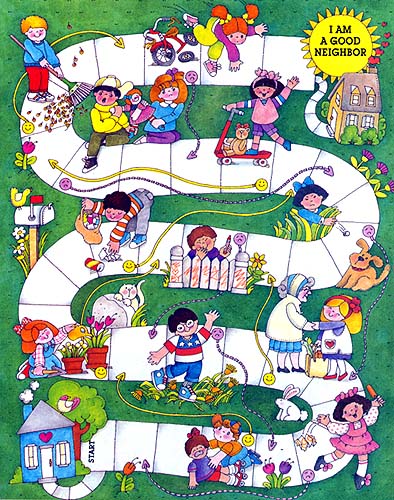“Sharing Time: My Home and Neighborhood,” Friend, Sept. 1992, 11
Sharing Time:
My Home and Neighborhood
Behold, the Lord hath created the earth that it should be inhabited; and he hath created his children that they should possess it (1 Ne. 17:36).
Through Jesus Christ, Heavenly Father created our world. He made the mountains. He made the oceans. He made the sun to shine by day and the moon to shine by night. “And all things which [He] had made were finished, and … God saw that they were good” (Moses 3:2).
Heavenly Father wanted us to live in a beautiful and good world. Every child needs a home and people who will love and care for him. And every child can care for and show love in his home.
When President Ezra Taft Benson was just twelve years old, his father was called on a mission. Ezra was the oldest child in the family, with six younger brothers and sisters. He knew that his mother would need him to help her make their home a cheerful and comfortable place. He woke up early each morning so that he could milk the cows before he went to school. His little brothers and sister laughed as he squirted milk into their mouths when they came into the barn to watch him, and he comforted them when they missed their father. He even dug vegetables from the snow so that they would have enough to eat. Ezra tried in every way to make his home a happy one.
Think about your home. Is it a place of love? Is it a place where people care for one another? Do you show respect, honor, and love for your home and those who live in it? Think about your neighborhood. Is it a good place? Do you show respect, honor, and love for your neighbors?
President Benson lived on a farm in Whitney, Idaho, when he was a child. There were chickens, milking cows, beef cattle, and horses. There were also neighbors. Ezra’s mother taught him to greet people with a polite “How do you do?” One afternoon while the family was seated at the dinner table, little Ezra noticed the bowl of boiled eggs and said courteously, “How do you do, eggs?” Everyone laughed, and it was a family joke that was retold for years.
Ezra helped his neighbors willingly when they needed extra people to do farm work. Some of the neighbors said that they never knew anyone who worked harder than he did.
When we show respect, honor, and love in our homes and neighborhoods, we are showing reverence for them, and in this way, we are letting Heavenly Father know that we are thankful for the beautiful and good world He created for us.
Instructions
You can learn ways to become a good neighbor by playing the game on page 10. Use buttons or small stones for markers. Write numbers 1–6 on small pieces of paper and put them into a bag. To play the game, shake the bag and draw a number. Move your marker the number of spaces indicated. If you land on a space showing good-neighbor activities, you move ahead to where the solid arrow points. But if you land on a space showing things you should not do, you must follow the broken arrow and move backward. Continue playing the game until each player becomes a good neighbor.

Illustrated by Julie F. Young
Sharing Time Ideas
-
Print the scripture from Mosiah 4:14–15 on wordstrips, so that you can build a list of parents’ responsibilities. Then have the children help build a parallel list of children’s responsibilities. Example: Parents should teach children not to fight and quarrel—Children should share willingly and be kind to brothers and sisters.
-
Discuss Mosiah 4:14–15, focusing on teaching children to not fight and quarrel one with another. Describe family situations where children tend to quarrel, then let the children role-play the sequences, suggesting different possible solutions.
-
Discuss Mosiah 4:28. Ask the children to describe situations where they might borrow from neighbors, and discuss why it is important to return what you borrow and possible consequences if the item is not returned.
-
If the weather and other conditions permit, divide the children into several groups, each with at least one leader. Have each group take a short walk in the neighborhood. Have one group search for pleasing images and scenes. Another could find things that they could fix or change to make the neighborhood nicer. A third group could look for ten things they have not noticed before.
-
Divide the older children into several groups. Give each group a copy of the Children’s Songbook. Have each group choose one song from the pink “Home and Family” section, read the verses to the song, and answer the following question: How could the ideas in this song help us to show more honor, respect, and love in our homes? Have one person from each group report. Ask groups of younger children to choose songs from the “Home and Family” section and illustrate them, then show their pictures to the rest of the children.
-
Draw a large map of your neighborhood. Let the children help you locate their homes, the church, stores, and other landmarks on the map. Discuss ways that they could show respect for the neighborhood, such as obeying specific laws and learning about and serving neighbors.